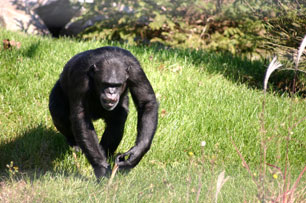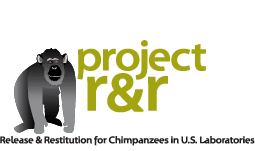October 23, 2008 • Posted in Related News


Pepper: (left) in her 5'x5'x7' ft. lab cage at LEMSIP; and, (right) on her sanctuary island at Fauna
Eleven years after their rescue from HIV/AIDS and other research, Sue Ellen, Rachel, Pepper, and others are now ambassadors for Project R&R: Release and Restitution for Chimpanzees in U.S. Laboratories, a national campaign to end the use of chimpanzees in invasive biomedical research. Their anniversary, celebrated at Fauna—the first sanctuary to accept HIV-infected chimpanzees—comes on the heels of research showing that the failure to develop a successful HIV/AIDS vaccine for humans can be attributed to the use of chimpanzees.
“An Assessment of the Role of Chimpanzees in AIDS Vaccine Research,” published this month in the international journal Alternatives to Laboratory Animals (ATLA), showed that most of the vaccines developed to date were tested in chimpanzees who endured decades of experiments. Almost all of the vaccines protected chimpanzees from HIV infection, but none were successful in humans. Investigation of the reasons chimpanzees are a poor model for HIV infection led the paper’s author, geneticist Jarrod Bailey, Ph.D., to conclude that “claims of the importance of chimpanzee research for human health are misleading and a call to return to their use is without scientific justification.”
As a result of rescues like that of Sue Ellen, Pepper, and others, the world is coming to know chimpanzees who suffered dearly in research. Gloria Grow, Fauna founder and Project R&R co-chair, notes, “Nearly every day, for eleven years, I have watched the effects of laboratory use on chimpanzees. And throughout this time, I thought if people only knew them, their stories, this use and abuse would stop. Now, with research showing how useless their suffering was, the point will be driven home: all the rest need to be released as well.”
The past decade has seen changes in the perception and use of chimpanzees in research. U.S. laws/policies now prohibit euthanasia for a lab’s convenience; require permanent protection from future use once “retired;” and have ended federal funding for breeding. Funding for chimpanzee research has declined while public outrage over their use has grown, and a recently introduced bill calls for an end to their use in invasive research in the U.S. (the Great Ape Protection Act, GAPA)—promising to add the U.S. to the list of eight countries that have already banned or severely limited chimpanzee research.
According to Theodora Capaldo, Ed.D., Executive Director of Project R&R, “With chimpanzee research we have all lost—millions of wasted taxpayer dollars and failed science. The real costs have been borne in the pain and suffering of a species, so close to our own. Individuals we know and care deeply about, like Pepper and Sue Ellen, are no different from the 1,100 others remaining in U.S. labs—some for 40 or 50 years. They too deserve sanctuary before it is too late. As a psychologist who cares deeply about people as well as other species, I see the tragic legacy of chimpanzee use in research, and I am convinced that only by protecting them and ending their use in biomedical research will we also be successful in helping humans.”

